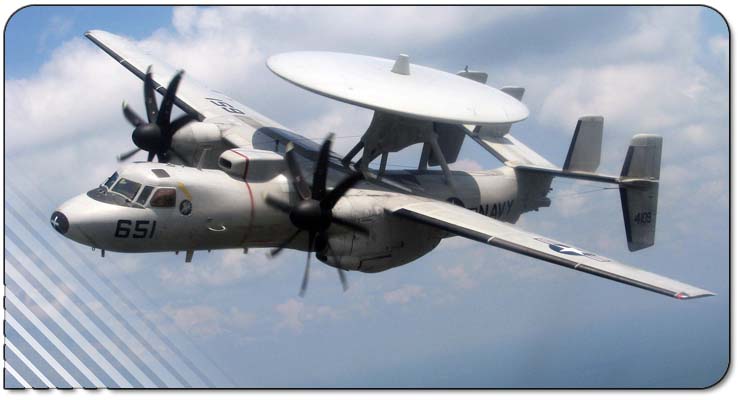Description:
The E-2 Hawkeye is the Navy's
all-weather,
carrier-based tactical battle management airborne early warning,
command and control aircraft. The E-2 is a twin engine, five
crewmember, high-wing turboprop aircraft with a 24-foot diameter radar
rotodome attached to the upper fuselage.
Features
The
Hawkeye provides all-weather airborne early warning, airborne battle
management and command and control functions for the Carrier Strike
Group and Joint Force Commander. Additional missions include surface
surveillance coordination, air interdiction, offensive and defensive
counter air control, close air support coordination, time critical
strike coordination, search and rescue airborne coordination and
communications relay. An integral component of the Carrier Strike Group
air wing, the E-2C uses computerized radar, Identification Friend or
Foe and electronic surveillance sensors to provide early warning,
threat analysis against potentially hostile air and surface targets.
Background
The
continuous improvements in early airborne radars by 1956 led to the
concept of an airborne early warning and command and control aircraft.
The first aircraft to perform this mission was the Grumman E-1 Tracer
(a variant of the S-2 Tracker anti-submarine aircraft), which saw
service from 1954 to 1964. The E-1's successor, the E-2 Hawkeye, was
the first carrier-based aircraft designed from the outset for the
all-weather airborne early warning and command and control mission.
Since replacing the E-1 in 1964, the Hawkeye has been the "eyes of the
fleet." Since its combat debut during the Vietnam conflict, the E-2 has
served the Navy around the world.
Hawkeyes directed F-14
Tomcat fighters flying combat air patrol during the two-carrier battle
group joint strike against terrorist-related Libyan targets in 1986. In
the early 1990s, E-2s provided airborne command and control for
successful Coalition Air Operations during the first Arabian Gulf War.
Directing both land attack and combat air patrol missions over Iraq,
the E-2 Hawkeye provided air control for the shoot-down of two Iraqi
MIG-21 aircraft by carrier-based F/A-18s in the early days of the war.
Later during the 1990s, E-2s supported Operations Northern and Southern
Watch over Iraq. E-2s also supported NATO operations over the former
Republic of Yugoslavia, including Operation Deny Flight. Recently in
Operations Enduring Freedom and Iraqi Freedom, E-2 Hawkeyes provided
critical Airborne Battle Management and Command and Control functions
supporting numerous Close Air Support and Battlefield Interdiction
missions. E-2s also have worked extremely effectively with U.S. law
enforcement agencies in drug interdictions operating from bases both
the United States and several foreign countries.
The current
version of the Hawkeye, the E-2C, became operational in 1973, and
surpassed one million flight hours in August 2004. The aircraft has
undergone several upgrades to its active and passive sensors, engines
and propellers. The newest variant of the E-2C (Hawkeye 2000) with its
new mission computer, improved radar displays and Cooperative
Engagement Capability (CEC), combined with the shipboard Aegis weapon
system, will form the cornerstone of future sea based Theater Ballistic
Missile Defense (TBMD).
Variants of the E-2C Hawkeye are also
flown by the Egyptian Air Force, Japanese Self Defense Air Force,
Republic of Singapore Air Force, Taiwan Air Force, and the French Navy.
Advanced Hawkeye (AHE)
Advanced Hawkeye
(AHE), the newest variant of the E-2 aircraft platform, is currently in
development and scheduled to be introduced to the Fleet in 2011. Using
the E-2C Hawkeye 2000 configuration as a baseline, AHE will feature a
state of the art radar with a two generation leap in capability and
upgraded aircraft systems that will improve supportability and increase
readiness. Key AHE program objectives include improved battle space
target detection and situational awareness, support of Theater Air and
Missile Defense (TAMD) operations, and improved Operational
Availability. The AHE mission will be to provide advance warning of
approaching enemy surface units, cruise missiles and aircraft, to
vector interceptors or strike aircraft to attack, and to provide area
surveillance, intercept, communications relay, search and rescue and
strike and air traffic control. The AHE is intended to meet airborne
early warning surveillance, battle management and TAMD needs as the
Navy develops its Sea Power 21 concepts in support of Joint Vision 2020. |
WEFT Description
-
- WINGS
- ENGINE
- FUSELAGE
- TAIL
|
|

